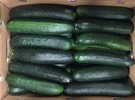"Generally, people have planted a little less everywhere, and that's being driven by higher costs." So says Neil Mazal of East Coast Farms & Vegetables of current cucumber production in North America.
Right now, production has transitioned from Georgia, with the exception of two late harvesting growers who are almost finished. "Production is now widespread in growing areas from South Carolina, North Carolina, New Jersey, Ohio, New York, Michigan, and Baja Mexico. There are small local deals in other areas, but production is still not abundant in any one area," he says.
Greenhouse production of cucumbers from Mexico, Canada, and the U.S. also continues, though Mazal notes there had been a flush of greenhouse cucumbers on the market. "The market was greatly depressed, and people were consigning greenhouse cucumbers," he says, noting retailers, however, weren't spot promoting greenhouse cucumbers and instead relied on ads planned two weeks in advance. However, the flush is over, and European-style cucumber prices are now higher.
Why less acreage? The lower amount of acreage planted isn't surprising given the number of increased costs growers are contending with--fuel, fertilizer, the lack of labor, and more. High fuel rates are of particular note given they are pressuring supplies that are available closer to home because supplementing from the West Coast, for example, is more cost-prohibitive.
The lower amount of acreage planted isn't surprising given the number of increased costs growers are contending with--fuel, fertilizer, the lack of labor, and more. High fuel rates are of particular note given they are pressuring supplies that are available closer to home because supplementing from the West Coast, for example, is more cost-prohibitive.
Meanwhile, demand is good for cucumbers. However, local deals are making their way into general demand. "There are little pockets everywhere of someone with cucumber," says Mazal. "And those smaller deals are trying to get more money for their product because they don't have the volume to help them overcome the additional costs we're all dealing with."
He does add that this year those local deals have a particular advantage at retail. "Retailers will try and buy that local production because they're saving on freight. They can buy just-in-time produce and can promote "buy local," says Mazal.
Range of pricing As for prices, they're spread out from a low of $8.35 F.O.B. to a high of $10.35. Selects with super selects are commanding higher price points ranging from $16.35 to $18.35. "With production increasing in most new areas, we can expect prices to ease off and could fall quickly," says Mazal.
As for prices, they're spread out from a low of $8.35 F.O.B. to a high of $10.35. Selects with super selects are commanding higher price points ranging from $16.35 to $18.35. "With production increasing in most new areas, we can expect prices to ease off and could fall quickly," says Mazal.
That range is also partly due to freight costs. 'With cucumber weights, the freight cost is a driving factor in the decision around where to buy
F.O.B. The F.O.B. cost may be lower in one area, but the freight cost to the end user may be prohibitively high," says Mazal.
Looking ahead, Mazal notes that, of course, growing conditions are also factoring into where cucumbers are being bought from. "One area might have too much rain while another area might be too hot and dry impacting quality," he says. "The bottom line is that transition time is time to research a little more than usual to find the best "deal." Keep inventory low as you follow the market down."
 For more information:
For more information:
Neil Mazal
East Coast Farms & Vegetables
Tel: +1 (561) 951-0876
neil@eastcoastfarms.us
https://www.eastcoastfarms.us/
